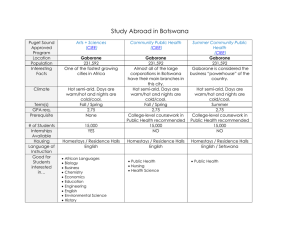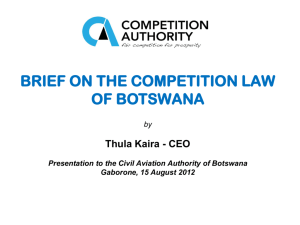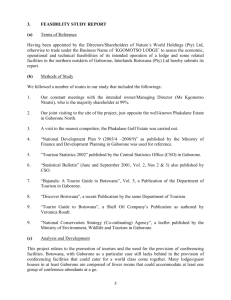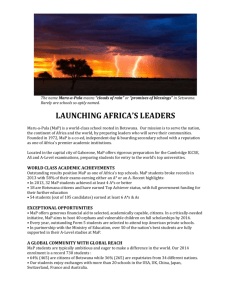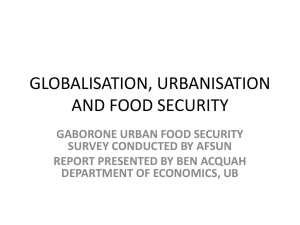Electromagnetic Fields and Health: A WHO Perspective Dr E. van Deventer Radiation Programme
advertisement
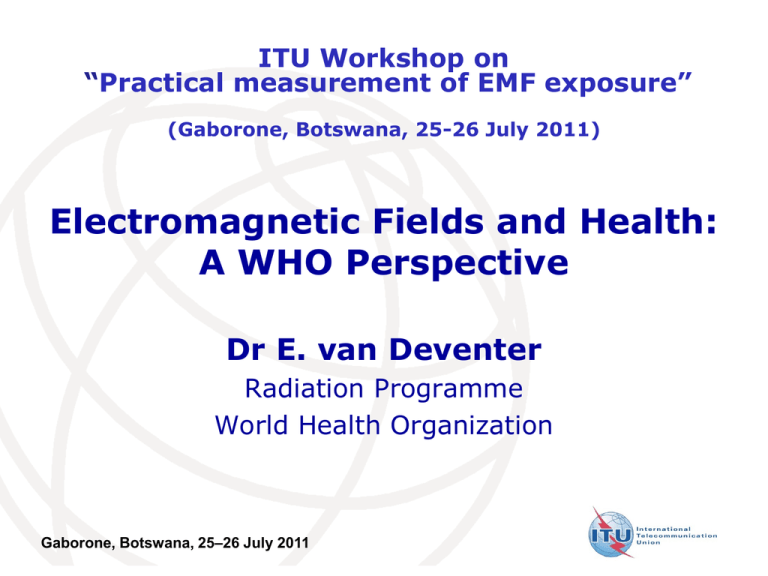
ITU Workshop on “Practical measurement of EMF exposure” (Gaborone, Botswana, 25-26 July 2011) Electromagnetic Fields and Health: A WHO Perspective Dr E. van Deventer Radiation Programme World Health Organization Gaborone, Botswana, 25–26 July 2011 1 OUTLINE Introduction Assessing the health risk Managing the potential risk Conclusions Gaborone, Botswana, 25–26 July 2011 2 Gaborone, Botswana, 25–26 July 2011 3 Gaborone, Botswana, 25–26 July 2011 4 Gaborone, Botswana, 25–26 July 2011 5 Radio Frequency Fields (100 kHz – 300 GHz) Navigation/Radar Wi-Fi Residential sources Telecommunications Commercial Emerging technologies Security scanners Gaborone, Botswana, 25–26 July 2011 Broadcasting 6 The Present EMF Context Increasing EMF human exposure due to electricity demand, medical technologies and wireless devices Increasing concern from the public Gaborone, Botswana, 25–26 July 2011 7 Gaborone, Botswana, 25–26 July 2011 8 The Present Scientific Knowledge Large and increasingly sophisticated database Known mechanisms Health effects not established below international guidelines Scientific uncertainty Gaborone, Botswana, 25–26 July 2011 9 WHO International EMF Project Established in 1996 Coordinated by WHO HQ A multinational, multidisciplinary effort to create and disseminate information on human health risk from EMF Gaborone, Botswana, 25–26 July 2011 10 WHO Partners in Radiation International Organizations International Advisory Committee National Authorities Collaborating Centres Gaborone, Botswana, 25–26 July 2011 11 Do EMFs pose a heath risk? Risk Assessment The Evidence Risk Perception Risk Management The Public Concern The Policies Gaborone, Botswana, 25–26 July 2011 12 OUTLINE Introduction Assessing the health risk Gaborone, Botswana, 25–26 July 2011 13 What do we know? 100 kHz 300 MHz 10 GHz Frequency Gaborone, Botswana, 25–26 July 2011 14 What do we know? Mechanisms of interaction 100 kHz 300 MHz 10 GHz Frequency Induced currents Induced currents and heating Surface heating Non-thermal effects?? Gaborone, Botswana, 25–26 July 2011 15 Reference Levels 1.E+06 106 ICNIRP (public) ICNIRP (occupational) IEEE C95.6 (public) IEEE C95.6 (occupational) IEEE C95.1 (public) IEEE C95.1 (occupational) 105 1.E+05 1.E+04 104 H [A/m] 103 1.E+03 102 1.E+02 10 1.E+01 11 1.E+00 10-1 1.E-01 10-2 1.E-02 1 1.E+01 10 1.E+02 102 1.E+03 103 1.E+04 104 1.E+05 105 1.E+06 106 1.E+07 107 1.E+08 108 1.E+09 109 1.E+10 1010 1.E+11 1011 1.E+12 1012 1.E+00 Frequency [Hz] Gaborone, Botswana, 25–26 July 2011 16 How do we evaluate the health risk from EMF? Gaborone, Botswana, 25–26 July 2011 17 Research Balance of studies needed http://www.niehs.nih.gov/emfrapid/booklet/emf2002.pdf Gaborone, Botswana, 25–26 July 2011 18 RF Studies (WHO Database, March 2009) Type of study Ongoing Not yet publishe d Physics 77 14 538 Epidemiology 41 12 311 Human 44 11 256 Animal 42 28 834 Cellular 60 28 503 Total 264 93 Gaborone, Botswana, 25–26 July 2011 Published 2442 !! 19 Laboratory Studies Cellular studies Genotoxicity Gene expression Animal studies Cancer Behaviour BBB Skin Human studies Sleep EEG Hormones EHS Gaborone, Botswana, 25–26 July 2011 20 Short-term effects (WHO fact sheet 193, June 2011) To date, research does not suggest any consistent evidence of adverse health effects from exposure to RF fields at levels below those that cause tissue heating. Research has not been able to provide support for a causal relationship between exposure to EMF and self-reported symptoms, or “electromagnetic hypersensitivity”. Gaborone, Botswana, 25–26 July 2011 21 Conclusions: “EHS is characterized by a variety of non-specific symptoms that differ from individual to individual… EHS has no clear diagnostic criteria and there is no scientific basis to link EHS symptoms to EMF exposure.” Gaborone, Botswana, 25–26 July 2011 22 Epidemiology Studies on mobile phones Tumours in head and neck Glioma, meningioma, acoustic neuroma, parotid gland Around 15 studies on the use of mobile phones Published: USA, Nordic countries, Hardell, INTERPHONE Ongoing: Cefalo, MOBI-Kids, COSMOS Gaborone, Botswana, 25–26 July 2011 23 INTERPHONE study (published 18 May 2010) Cases: 2,765 gliomas 2,425 meningiomas 1,121 acoustic neuroma 109 malignant parotid gland Controls: 7,658 Gaborone, Botswana, 25–26 July 2011 24 Long-term effects (WHO fact sheet 193, June 2011) No increased risk of glioma or meningioma with mobile phone use of more than 10 years Indications of increased risk of glioma for heavy users Biases and errors prevent a causal interpretation. No available data for long-term use (15-20 ans) No available data for children Gaborone, Botswana, 25–26 July 2011 25 http://www.who.int/mediacentre/factsheets/fs193/en/index.html Gaborone, Botswana, 25–26 July 2011 26 Epidemiology Wi-Fi Base stations and wireless networks Some studies have been performed Well-being and performance Cancer Difficulty of personal exposure assessment GSM GSM 3G Wi-Fi Kenneth R. Foster, Radiofrequency exposure from wireless LANs utilizing WI-FI technology. Health Phys. 92(3):280 –289; 2007 Gaborone, Botswana, 25–26 July 2011 27 OMS Conclusions: “Considering the very low exposure levels and research results collected to date, there is no convincing scientific evidence that the weak RF signals from base stations and wireless networks cause adverse health effects” Gaborone, Botswana, 25–26 July 2011 28 WHO Health Risk Assessment Risk assessment of all health outcomes (Environmental Health Criteria) Hazard identification and classification of possible carcinogens (Monographs) Gaborone, Botswana, 25–26 July 2011 29 Background IARC Monographs The IARC Monographs are a series of scientific reviews that identify environmental factors that can increase the risk of human cancer National and international health agencies use the Monographs As a source of information on potential carcinogens As scientific support to guide their actions to prevent exposure to potential carcinogens Gaborone, Botswana, 25–26 July 2011 30 Background IARC Monographs Initiated in 1969 950+ agents have been evaluated Volume 80: Non-Ionizing Radiation, Part 1: Static and Extremely LowFrequency (ELF) Electric and Magnetic Fields, 2002 Volume 102: Non-Ionizing Radiation, Part 2: Radiofrequency Electromagnetic Fields, Working Group meeting 24-31 May 2011 Gaborone, Botswana, 25–26 July 2011 31 From V. Cogliano, Workshop on "Characterizing evidence in EMF risk assessment", Berlin, May 2006, http://evidence.pureres.net Gaborone, Botswana, 25–26 July 2011 32 IARC Evaluation Volume 102 - Radiofrequency Fields The Lancet Oncology Volume 12, Issue 7, pp. 624 - 626, July 2011 doi:10.1016/S1470-2045(11)70147-4 Published Online: 22 June 2011 Gaborone, Botswana, 25–26 July 2011 33 IARC Evaluation Volume 102 - Radiofrequency Fields RF fields classified as Group 2B “Possible Carcinogenic” based on limited human data on association between glioma and acoustic neuroma and exposure to RF-EMF from wireless phones (epidemiologic studies). limited animal data Evidence for other exposures (e.g. base stations, wifi, …) and outcomes (other cancers) considered insufficient for any conclusion Gaborone, Botswana, 25–26 July 2011 34 Agents Classified by IARC (950) IARC Classification Carcinogenic to humans (107) (usually based on strong evidence of carcinogenicity in humans) Probably carcinogenic to humans (59) (usually based on strong evidence of carcinogenicity in animals) Possibly carcinogenic to humans (267) (usually based on evidence in humans which is considered credible, but for which other explanations could not be ruled out) Gaborone, Botswana, 25–26 July 2011 Examples of Agents Asbestos Alcoholic beverages Benzene Mustard gas Radon gas Solar radiation Tobacco (smoked and smokeless) X-rays and Gamma Creosotes Diesel engine exhaust Formaldehyde Polychlorinated biphenyls (PCBs) Coffee Gasoline engine exhaust Pickled vegetables ELF magnetic fields Styrene RF fields 35 IARC Classification Gaborone, Botswana, 25–26 July 2011 36 WHO and EMF Research What has been done? • WHO Research reviews • Health Risk Assessments Gaborone, Botswana, 25–26 July 2011 time 37 Environmental Health Criteria Electromagnetic Fields 2009 2010 2006 2007 RF fields 2012 Gaborone, Botswana, 25–26 July 2011 38 WHO and EMF Research What has been done? What needs to been done? • WHO Research reviews • Health Risk Assessments WHO Research Agenda Gaborone, Botswana, 25–26 July 2011 time 39 OUTLINE Introduction Assessing the health risk Managing the health risk Communicating the scientific knowledge Developing standards and regulations Gaborone, Botswana, 25–26 July 2011 40 Gaborone, Botswana, 25–26 July 2011 41 Risk Perception and Communication WHO Risk Handbook • For programme managers who need basic information on EMF risk perception, communication and management • Available in English •Translated into Spanish, Italian, German, French, Russian, Bulgarian, Dutch, Polish, Portuguese, Hungarian and Japanese •Available on the web www.who.int/emf Gaborone, Botswana, 25–26 July 2011 42 Elements of Risk Perception • • • • • • • • Gaborone, Botswana, 25–26 July 2011 Extent of health risk Probability of occurrence Uncertainty Ubiquity Pattern of exposure Delayed effect Inequity and injustice Voluntary vs. involuntary exposure 43 Managing EMF Risk Communication Gaborone, Botswana, 25–26 July 2011 44 The Message What to Communicate? Communicating the science Putting the EMF risk in perspective Explaining policy measures Gaborone, Botswana, 25–26 July 2011 45 Stakeholders With whom to communicate? Scientific Community Health Community Industry Law Associations General Public Government Media Gaborone, Botswana, 25–26 July 2011 46 WHO and STANDARDS WHO does NOT develop EMF standards but facilitates international consensus on standards International bodies, ICNIRP and IEEE/ICES, develop international guidelines for human protection from EMF exposure Gaborone, Botswana, 25–26 July 2011 47 Gaborone, Botswana, 25–26 July 2011 48 Norms, Standards and Guidelines Emission standards have specifications that limit the EMF emissions from devices Gaborone, Botswana, 25–26 July 2011 Exposure standards have specifications that limit EMF exposure to people 49 Relevant Authorities Non-governmental and international organizations Emission standards Measurements standards Gaborone, Botswana, 25–26 July 2011 Exposure standards 50 Relevant Authorities National bodies Ministry of Health Ministry of Labour Ministry of the Environment Ministry of Transport Ministry of Energy Ministry of Telecommunications …. Gaborone, Botswana, 25–26 July 2011 51 Policy documents …. http://www.who.int/peh-emf/standards/ Gaborone, Botswana, 25–26 July 2011 52 Framework for Developing EMF Standards Motivation Concerns about public safety because of increasing EMF exposures from new technologies Many countries currently considering EMF standards Large differences between national standards http://www.who.int/peh-emf/standards/framework/en/index.html Gaborone, Botswana, 25–26 July 2011 53 Model Legislation To assist countries without appropriate legislation to protect their population from EMF Provides a legal framework to provide protection from EMF http://www.who.int/peh-emf/standards/emf_model/en/index.html Gaborone, Botswana, 25–26 July 2011 54 Model Legislation Purpose to establish limits on human exposure to EMF that will provide protection against known adverse health effects from any installation or device emitting such fields Scope Minimum requirements for the protection of the public and workers Gaborone, Botswana, 25–26 July 2011 55 Model Legislation Purpose to establish limits on human exposure to EMF that will provide protection against known adverse health effects from any installation or device emitting such fields Scope Minimum requirements for the protection of the public and workers EMF frequency range 0 to 300 GHz Gaborone, Botswana, 25–26 July 2011 56 Model Legislation EMF limits: Adoption of international standards to limit EMF exposure of people (ICNIRP guidelines) emissions of EMF from devices (IEC and IEEE device emission standards) Uniform application of the Act across the national jurisdiction Gaborone, Botswana, 25–26 July 2011 57 Model Legislation (cont'd) Compliance Range of options that the Minister may consider appropriate Establish or nominate an agency to administer compliance Enforcement Owner of installation to ensure compliance in public places and to provide training to workers (else general public status) Record keeping Maintenance of records of exposure measurements Information provision as appropriate Gaborone, Botswana, 25–26 July 2011 58 OUTLINE Introduction Assessing the health risk Managing the potential risk Conclusions Gaborone, Botswana, 25–26 July 2011 59 Challenges to governments…. Rapidly evolving RF technologies Launched on the market before health evaluation Disparities in risk management measures and regulations around the world Concern from the public Gaborone, Botswana, 25–26 July 2011 60 Conclusions Need for clear roles and responsibilities in government on this topic Need for adoption and compliance of health-based standards Need for a public information program and dialogue with stakeholders Need for promoting research to reduce uncertainty We are a "global village" Gaborone, Botswana, 25–26 July 2011 61 The International EMF Project Radiation and Environmental Health Public Health and Environment World Health Organization 21 Avenue Appia CH-1211 Geneva 27 Switzerland email: emfproject@who.int website: www.who.int/emf Gaborone, Botswana, 25–26 July 2011 62
